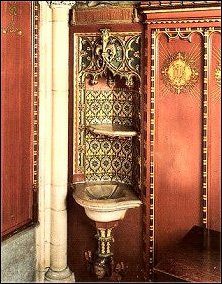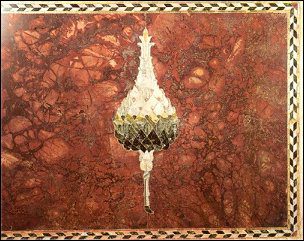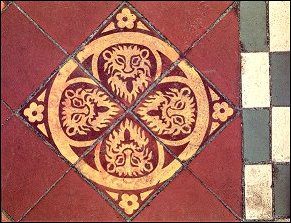Holy Rood has been styled a summary of Bentley’s knowledge and resources. If this is so then Holy Rood sanctuary must represent a focal point of his genius. Here a wide variety of materials, colours, textures and patterns are blended into a rich harmonious whole from the top of the glorious east window to the marble of the altar steps, while the eye is drawn to two centres of interest, the crucified Christ on the great rood and the golden tabernacle of the real presence. As one moves nearer the beauty of the whole conception resolves itself into refinements of exquisite detail, with the emergence of new artistic and architectural forms as the north and south sides of the chancel come into view.

Architecturally the chancel is unusual. The whole length of the north and south sides are taken up by triple arcades which support a gallery lit by large clear windows. The inner side of the gallery carries the shafted columns of an upper story triple arcade, the apex of which pierces the barrel vault of the sanctuary ceiling.
Below the gallery is an ambulatory which passes between the chancel and the chapels to the north and south side of it and behind the high altar. The ambulatory terminates at the piers of the chancel arch. The northern pier gives access to the pulpit and the southern pier to the gallery, rood loft and bell turrets. The altar, reredos and window occupy most of the east side, panelling and murals filling the remaining space. It is a structure of great interest, conveying a sense of mystery in that there seems always to be further depths and distances, always more to be seen than meets the eye.
This splendid and ingenious structure is superbly decorated. The columns of the lower arcades are adorned with ballflowers and have carved capitals with vine leaf and grape relief of high quality. The first arch on either side is open to the ambulatory and the side chapels. The second arch on the north side is closed by a handsome gilded ironwork grille surmounted by a cornice pierced along its golden length with the prayer of the penitent thief and the answer from the crucified Christ: “Domine, memento mei quando veneris in regnum tuam. Amen, dico tibi, hodie mecum eris in paradiso.” The opposite arch on the south side contains the oaken sedilia with traceried panels and a canopy. The third arch on both sides of the sanctuary is completely filled in. Up to the column capitals there is a deep red panelling with polychrome and gilt cusps and moulding. At the top of each panel an intricate golden IHS on a grey background sends out golden rays through an encircling green crown of thorns. On both sides there is set into the panelling a feature of particular beauty. On the north there is a graceful projecting wooden aumbry painted like the panels in gilt and deep red, but decorated with golden pomegranates and inscribed “Sanctum Chrisma.”

On the south side is an exquisite alcoved piscina, the stone basin and shelf backed by green and gold diaper work, the top canopied by an ogee arch with gilt pendants and fleur de lys finial. Quite beautiful and highly original tracery brings the arch and the finial to a correspondence with the rectangular frame.
The tympana of both third arches are filled in a favourite medium of Bentley’s, ‘opus sectile’, a picture made up in pieces of ceramic rather in the way that the picture is composed in a stained glass window. That on the north represents the Entombment; facing it on the south the Agony in the Garden. Both are fine examples of this particular art form and are from cartoons by George Daniels.
The wall space above the panelling and the arches up to the balustrade of the gallery is plastered and covered in mural painting. On each side are six life-size half figures of saints within a circular frame of roses, vines and pomegranates. Represented on the north side from east to west are St. Bernard, St. Alban, St. Cuthbert, St. Gregory the Great, St. Oswald and St. Alphege. On the south side in similar order are St. Francis of St. George, St. Augustine of Canterbury, St. Anselm, St. Edward the Confessor and St. Thomas of Canterbury. Close to the rood loft the chancel wall on either side is painted with an angel seated on a vine stem and carrying a scroll. That on the north reads “Omnes Sancti Pontifices et Confessores, orate pro nobis.” The south scroll: “Sancti Discipuli Domini, orate pro nobis.”
On the north pier is placed a fine carved oaken pulpit and sounding board. The base of the pulpit rests on a stone corbel which tapers down to a carving of a squirrel among oak leaves gnawing at an acorn. Let into the chancel arch just beside the pulpit is an engraved stone recording the consecration of the church on 5th July 1900 and the installation of the relics of Sts. Domitilla and Constantia. On the pier to the left and below the pulpit is the foundation stone laid by Cardinal Manning on the Feast of the Beheading of St. John the Baptist, 1889.
On the west side of the south pier, i.e., facing the nave, a lovely mural of two winged angels supporting a deep red tapestry forms a background to the shrine of the Sacred Heart. The alabaster statue, designed by Bentley and probably carved by the same Henry McCarthy who produced the Bentley memorial medallion, is a work of considerable merit. The shrine itself of richly carved and gilded Kauri pine with a particularly fine canopy, is supported on a splendid marble pedestal.
The chancel arch is set high, very near the vault. The moulding carries projecting paterae carved with the words “ADORAMUS TE”. The high arch allows for the height of the Rood and opens to clear view the east window and the altar. The Rood displays the agony and the tragedy of the crucifixion, but the altar and east window constitute a joyful and triumphant statement of the Victory of the Cross. The whole east end of Holy Rood is a blaze of colour, crimson and gold predominating on the altar and its surround; red, green and gold in the glorious window above it; at the heart of it all the tabernacle, a glowing gem of craftmanship in gilded bronze set with enamel and precious stones and surmounted by a pelican. The tabernacle is recessed into a backing of marble-framed grained limestone panels which, at the height of the tabernacle, extend to the full width of the altar.

A single slab of red marble forms the altar frontal. It is edged with a band of pearl, gold and green mosaic and embellished with two elegant pomegranates in marble and mother of pearl.
The intricately carved and gilded wooden reredos is canopied and pinnacled in typical 14th century style. Its prominent red and gold wings rest upon a gradine of banded grey Derbyshire and red Brescia marble; the four main panels are painted with white robed angels carrying the emblems of the evangelists*. The wall space on either side of the reredos up to the height of the dorsal marbling has deep red panelling similar to that in the third sanctuary arcades; above this and up to the gallery are two wall paintings. On the north side Christ is represented wearing a red robe and crowned with thorns being mocked by the crowd. On the south side is the betrayal in the Garden of Gethsemane.
Filling the whole space between the reredos and the vault is the east window of seven lights. In the centre is the Holy Rood, now green and bursting with life, rooted in the world symbolised by a field full of flowers. From the foot of the Rood flow rivulets carrying the water of life to the world, while Apostles either are grouped to the right and left. Above the Rood sits Christ in glory with rays of light beaming from his wounded hands, feet and side, Our Lady kneels on his right, St. Joseph is on the left and above all are angels making music. To the left of the Apostles stand the proto-martyrs: St John Houghton, first martyr of the Reformation; St. Alban, first British martyr and St. Stephen, the first Christian martyr, with stones carried in the folds of a lovely ruby coloured cloak. To the right of the Apostles St. Thomas Becket stands with the sword of his martyrdom in his head, beside him in cardinal’s robe is St. John Fisher and behind carrying his sword of martyrdom is St. Paul. Below are more musical angels.

The altar steps are of white marble; in the risers, tiles are set to form the words “Sanctus, Sanctus, Sanctus” and “Pro nobis obediens usque ad mortem.” The superb sanctuary flooring is partly marble and partly encaustic tile, some with a favourite motif of Bentley, a lion’s head with its tongue sticking out. As a total conception the chancel is a triumph of architecture, artistry and craftsmanship.